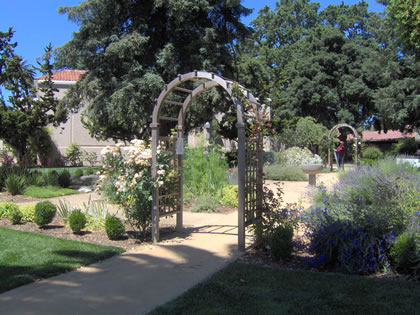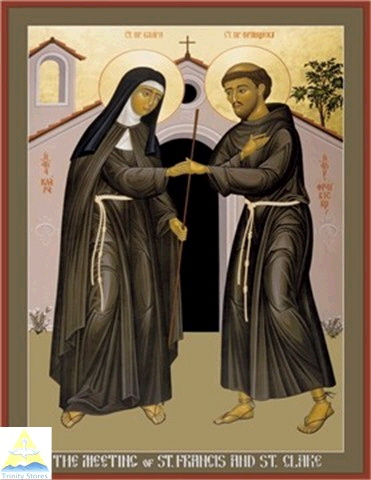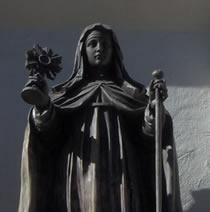

Meeting of Saints Clare and Francis © 1985 Br. Robert Lentz, OFM Image used courtesy of Trinity Stores
Clare of Assisi (1193-1253) may be unique among the saints of the Catholic Church for the abundance of horticultural references surrounding her life and legacy. Commemorating Clare with a garden is particularly appropriate because she herself was often compared to a plant or garden. This may have been inspired in part by her mother’s name, Ortolana, which means “good gardener.”
In her Testament written ca. 1253 Clare uses gardening metaphors to describe the relationship between Francis and her religious community: “The Lord gave us our most blessed Father Francis as Founder, Planter, and Helper in the service of Christ and in those things which we have promised God and him our Father; and in his lifetime he was ever solicitous in word and in work to cherish and foster us, his little plants.”
Written two years after her death, Clare’s Bull of Canonization (1255) calls the convent of San Damiano “the garden of the Lord” and her religious order “a vineyard of poverty” and “a garden of humility.” It declares that Clare herself was “truly a noble and lofty tree with wide-spreading branches” and “a fountain of the water of life” that has “watered many nurseries of religious life.”
A memorial garden to Clare is in keeping with Franciscan spirituality that celebrates the beauty and goodness of nature, the Lord’s creatures.
Francis wrote his greatest expression of his love of God and nature, The Canticle of the Creatures (1225), “Praised be You, my Lord, with all your Creatures, especially Sir Brother Sun…” while recuperating from illness in a reed hut in the garden of San Damiano where Clare was Abbess.
Francis' love of creatures extended even to invertebrates and vegetation: “Even for worms he [Francis] had a warm love, since he had read this text about the Savior: “I am a worm and not a man.” That is why he used to pick them up from the road and put them in a safe place so that they would not be crushed by the footsteps of passersby….Whenever he found an abundance of flowers, he used to preach to them and invite them to praise the Lord, just as if they were endowed with reason.” Thomas of Celano, Life of St. Francis 1:29

Statue of St. Clare on facade of Mission Santa Clara at SCU
A garden commemorating St. Clare is especially appropriate at her namesake mission and university. This garden brings Clare’s legacy to life for visitors and the university community. Viewers gain an understanding of the medieval symbolism of plants and herbs. They will also learn about the plants commonly grown in convent gardens and hence the way of life of the ‘Poor Clares,’ the religious community founded by St. Clare that practiced strict poverty in the tradition of Francis himself. Most importantly, visitors learn how the spirituality of St. Clare resonates today, as they watch with her in the Garden of Gethsemane, marvel at her favorite flowers as the beautiful creations of God, and consider the impact of her life upon the world, this “little plant” of the “little poor man” of Assisi.
This web site was written and designed by Nancy Lucid whose research was supported by a generous grant from the Bannan Institute for Jesuit Educational Mission at Santa Clara University.
For questions regarding the web site contact Nancy Lucid. All rights reserved.